Child during the Auditory Steady State Response (ASSR) test


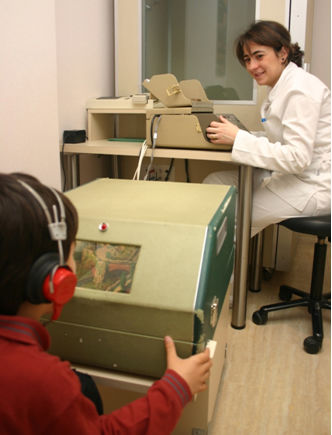
HEARING IMPAIRMENT IN CHILDREN
Impaired hearing is a particularly serious problem during infancy, as both the child’s intellectual and social development largely depend on the correct functioning of the ears.
1 out of every 100 new-born babies has a hearing impairment, with severe hearing impairment occurring in 1 out of 750 cases. Similarly, 40% of children, by the time they reach the age of 5, will have experienced serous otitis media (fluid in the middle ear) lasting for longer than 3 months, which is a frequent cause of delayed speech acquisition and learning. This is why the Paediatric Audiology Unit was founded, for the diagnosis and early treatment of the condition.
Alarm bells: how to tell if your child has impaired hearing?
- is unusually calm;
- doesn’t turn his/her head in response to strong or familiar sounds;
- doesn’t make articulated sounds.
From 1 to 2 years. The child:
- hasn’t started talking;
- doesn’t understand simple orders;
- doesn’t recognise his/her own name.
From 3 to 4 years. The child:
- often responds to questions with “what?”;
- is unable to construct sentences of three or more words;
- is unable to tell you what’s wrong.
In general
- frequent colds and otitis, snoring, breathing with the mouth open
- introverted, distracted or aggressive
- delayed learning
- concerns of the parent or teacher regarding the child’s hearing
Auditory Steady-State Evoked Potentials (ASSEPs)
There has been increasing awareness among paediatricians, paediatric otorhinolaryngologists, speech therapists and psychologists of the need for the early diagnosis of deafness. The huge benefits of early detection have resulted in screening programmes being made available in maternity wards.
Within this context, the Jordi Coromina ENT Clinic of the Teknon Medical Centre in Barcelona has set up the Paediatric Audiology Unit, coordinated by paediatric audiologist Dr Carlos Costa. This Unit has been developing its neonatal screening program for a number of years.
Whenever a child does not pass an auditive screening or where there is reason to suspect a hearing impairment, it is extremely important to offer a wide range of diagnostic tools, in order to determine the DEGREE AND TYPE of hearing loss as accurately and objectively as possible. Furthermore, any delay in performing audiological (hearing) tests must be avoided, as children with hearing loss must begin speech therapy and adapt to the fitting of a hearing aid by the age of 6 months.
The limitations of Brainstem Auditory Evoked Potentials (BAEPs) in determining hearing sensitivity in children are well-known; they only provide information on frequencies between 2,000 and 4,000 Hz. The test does not cover the remaining frequencies, which are actually the most important ones.
The Paediatric Audiology Unit, pursuing its interest in the successful social integration of children with hearing impairments, has been using the Auditory Steady State Response (ASSR) technique since 2004.
The ASSR test is a newly implemented electrophysiological technique for determining the hearing threshold across all the frequencies of the audiogram (graph showing results of the audiometer). It allows for reliable audiometric testing across the entire frequency spectrum of human hearing, instead of solely focusing on high-pitched tones.
This technique is particularly useful in cases where an accurate hearing test cannot be performed due to the child’s age or illness (children between the ages of 3 and 4/5 months)
The Paediatric Audiology Unit team uses its extensive expertise to obtain a reliable, objective and accurate diagnosis of your child’s hearing complaint, which is the only valid tool for being able to start rehabilitation.
- otoacoustic emissions
- Brainstem Auditory Evoked Potentials (BAEPs)
- Auditory Steady State Response (ASSR)
- paediatric audiometry (paediatric audiometry and Suzuky Test)
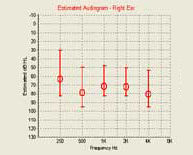
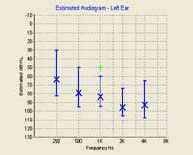
Example of an ASSR test on a child with a severe neurosensory hearing impairment: we see the audiometric curve for the entire frequency spectrum from 250 Hz to 4,000 Hz. The information provided by this screening allows us to fit hearing aids more efficiently in order to achieve optimum performance.
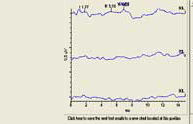
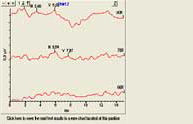
The BAEPs of the same child, on the other hand, only provide us with information on the hearing threshold from 2,000 to 4,000 Hz, and no specific data is supplied for the remaining frequency ranges. Compared to the ASSR test, the information provided by BAEPs is incomplete
 by Develona
by Develona